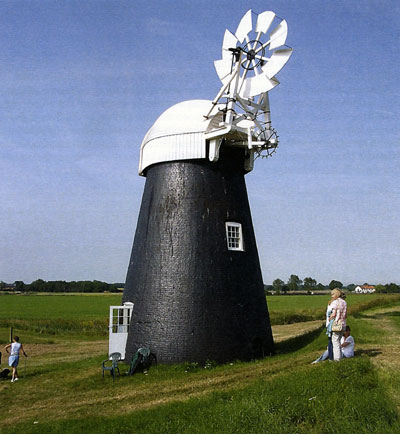
Runham Swim north drainage pump River Bure |
 |
c.1940 |
Runham Swim north wind pump had a 3 storey tarred red brick tower, 30ft high to its curb, containing two doors, one window and a Norfolk boat shaped cap with a petticoat. Power to the internal scoop wheel designed to pump water from the marshes into the River Bure was supplied by patent sails and the cap was turned to wind by an 8 bladed fantail with a Y wheel.
|
The fan star was found to be inscribed W.T. England, Millwright, Yarmouth 1896.
|
Runham Swim north wind pump was often called Child's Mill although the name 'Swim' was coined by virtue of cattle being herded down the track to the river where they swam across to graze on the marshes on the opposite side. This was also the site of an old ferry across the River Bure.
|
In 1973, Arthur Smith noted that the mill was derelict with only the lower boarding of the cap still in place. The stocks remained, along with the windshaft, brakewheel, fan cradle and the striking wheel chain. The gearing inside the mill was also intact.
|
 |
10th July 1973 |
 |
1989 |
 |
14th July 2013 |
Runham Drainage Mill was open to the public for the first time on 14 July and the hot weather brought a good flow of visitors down Swim Road (so named because cattle were brought down the track and swum across the River Bure). |
 |
|
O. S. Map 1884 Runham Swim north above river; Runham Swim south below river Courtesy of NLS map images |
1805: Original mill working just to the east of the present site July 1851: Commissioners for Drainage advertised for contractors to build new pump to replace earlier pump c.1852: Thomas_Smithdale built new windpump designed by William_Thorold 1916: 16hp hot bulb paraffin engine installed as an auxiliary drive in times of low wind c.1939: Mill ceased working after teeth came out of headwheel and repairs were refused by IDB 1940: Mill becoming derelict, cap and machinery in situ c.1940: Internal scoopwheel sold for scrap July 1973: Mill lying derelict with only lower boards of cap remaining 1979: Cap gone but stocks, brakewheel and fantail suports still in situ 1983: Mill restoration commenced by Norfolk Windmills Trust 1984: New cap installed 1987: Mill restoration nearing completion, although without sails 2014: Mill owned by local farming family, the Watts and maintained by Norfolk Windmills Trust 14th July 2013: Mill open to the public for the first time |
If you have any memories, anecdotes or photos please let us know and we may be able to use them to update the site. By all means telephone 07836 675369 or
|
| Nat Grid Ref TG 47000998 | Copyright © Jonathan Neville 2014 |